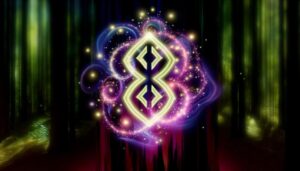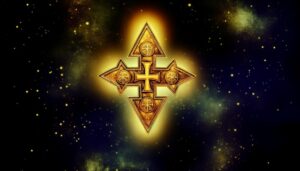Triple Yin Yang Symbol: What Is It and Its Meaning?
The Triple Yin Yang symbol, rooted in ancient Chinese philosophy, embodies an advanced representation of harmony and balance through its dynamic interplay of opposing forces. Originating from texts such as the I Ching and Tao Te Ching, it integrates influences from Confucianism, Taoism, and Buddhism.
Comprising three interlocking circles, this triadic structure symbolizes a more complex equilibrium, emphasizing that no force exists in isolation and highlighting the continuous cycle of mutual influence and transformation. This symbol underscores the fundamental Chinese philosophical notion that balance and harmony are essential for universal equilibrium.
Discover how this symbol seamlessly intertwines cultural depth and philosophical insight.
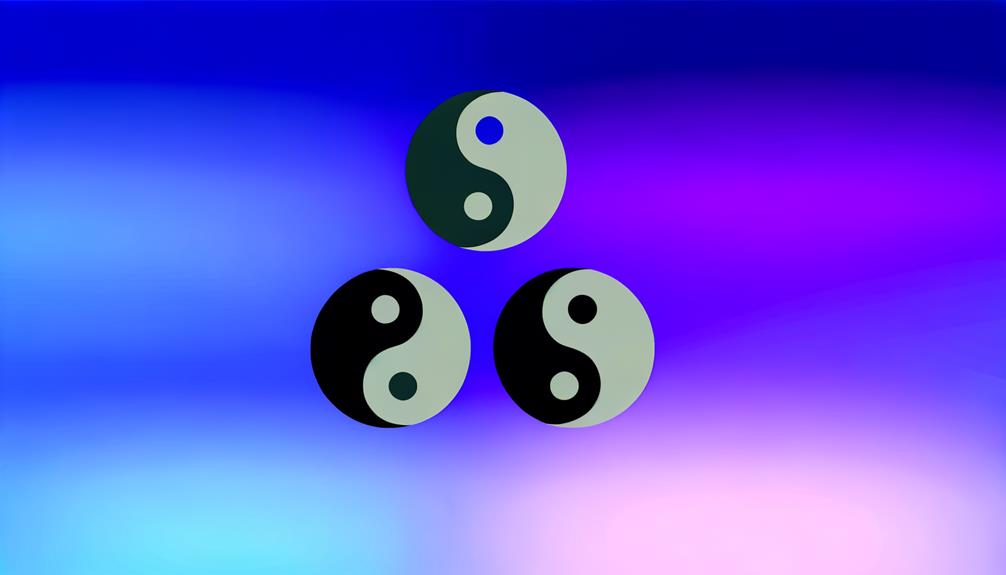
Key Takeaways
- The triple Yin Yang symbol represents a more complex balance and harmony through interlocking circles.
- It highlights interconnectedness and emphasizes the necessity of each force for the existence and function of the others.
- The symbol embodies the continuous cycle of mutual influence and transformation between opposing forces.
- It integrates a third balancing force, illustrating a dynamic equilibrium within a holistic system.
- The symbol serves as a powerful emblem for spiritual growth, mindfulness, and embracing paradoxes in life.
Historical Background
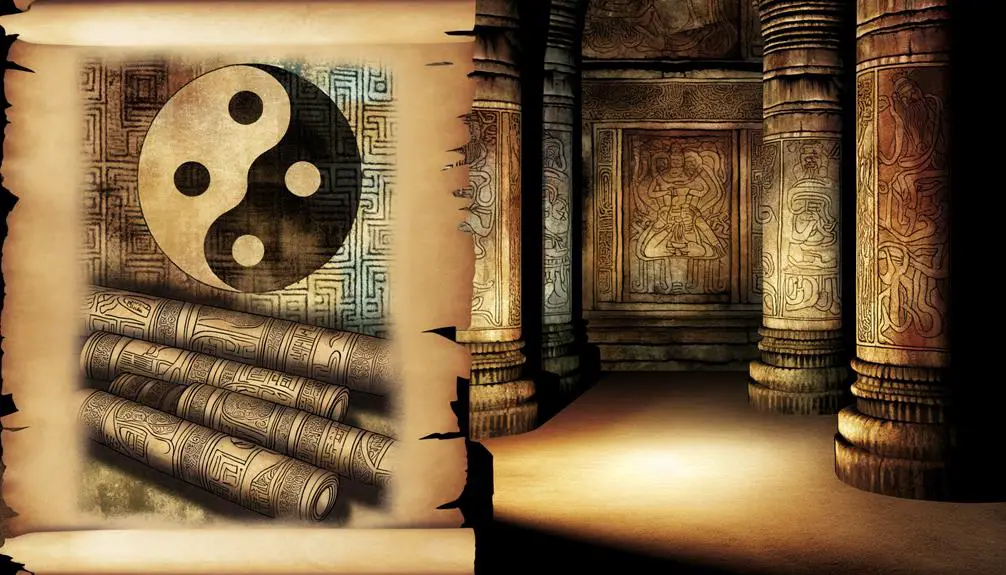
The historical background of the Triple Yin Yang symbol traces its origins to ancient Chinese philosophical and cosmological traditions, reflecting the intricate interplay of dualities that define the natural and metaphysical world.
Rooted in the classical texts such as the I Ching and Tao Te Ching, the symbol embodies principles of balance, harmony, and cyclical change. These texts elucidate the dynamic equilibrium between opposing forces, which is fundamental to understanding existence and transformation.
The Triple Yin Yang symbol, a more complex iteration, emerged later, encapsulating an expanded perspective on interrelated dualities. Its evolution mirrors the broader philosophical discourse in Chinese thought, encompassing Confucian, Taoist, and later, Buddhist influences, thereby enriching its cultural and metaphysical significance.
Symbolic Components
The Triple Yin Yang symbol intricately embodies the fundamental elements of Yin and Yang, representing the dualistic nature of existence.
This triadic configuration emphasizes the interconnectedness of opposing forces, suggesting a more complex interplay and mutual dependence than the traditional dual symbol.
Ultimately, it underscores the philosophical pursuit of achieving balance and harmony within a multifaceted universe.
Yin and Yang Elements
Embedded within the Triple Yin Yang symbol are the contrasting yet complementary elements of Yin and Yang, each representing fundamental dualities in traditional Chinese philosophy such as darkness and light, femininity and masculinity, and passivity and activity.
Yin embodies qualities like receptivity, intuition, and inward reflection, symbolized by darkness and the moon. Conversely, Yang signifies attributes of assertiveness, logic, and outward action, represented by light and the sun.
The Triple Yin Yang symbol magnifies these dualities, illustrating not only their individual attributes but also their intricate balance. This balance is crucial in understanding the essence of harmony in the universe, reflecting a dynamic equilibrium where opposites coexist and interdepend, each essential to the existence and function of the other.
Interconnectedness of Forces
Understanding the Triple Yin Yang symbol requires a deeper examination of how its components illustrate the interconnectedness of forces, where each element not only defines but also sustains the other in a continuous cycle of mutual influence and transformation.
This triadic symbol extends the traditional dualistic concept by incorporating a third aspect, often representing a mediating or balancing force. In cultural context, this suggests a more complex interplay of energies, where creation, preservation, and destruction coexist in a dynamic equilibrium.
The symbolic components—typically depicted as intertwined swirls—emphasize that no single force is isolated. Each element's existence and function are contingent upon the other, creating a holistic system in which change and stability are eternally interwoven.
Balance and Harmony
How does the Triple Yin Yang symbol encapsulate the concepts of balance and harmony through its intricate symbolic components?
This symbol, an evolution of the traditional Yin Yang, incorporates three interlocking circles, each representing a dynamic interplay between complementary forces.
Rooted in Daoist philosophy, it extends the dualistic nature to a triadic structure, signifying a more complex balance.
The additional element introduces layers of interdependence, suggesting that harmony arises not from a binary opposition but from a tripartite equilibrium.
This configuration symbolizes the perpetual flow of energies—light, dark, and their synthesis—emphasizing that true balance is multifaceted.
In cultural context, it underscores the Daoist principle that harmony in life and the universe is achieved through the nuanced interplay of multiple forces.
Philosophical Significance
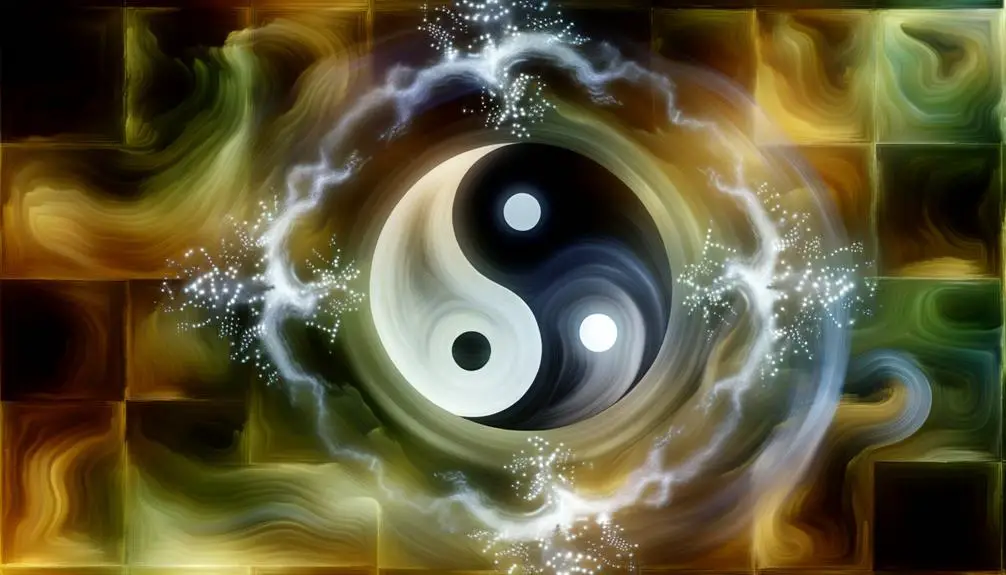
The Triple Yin Yang symbol, deeply rooted in ancient Chinese philosophy, encapsulates a complex interplay of dualities and triadic harmonies that extend beyond the conventional binary Yin and Yang.
This intricate emblem represents an evolution of the binary system into a more nuanced triadic framework, suggesting the presence of a third, balancing element. Philosophically, this third element can be interpreted as the mediator that harmonizes the dynamic tension between Yin and Yang, offering a more holistic understanding of existence.
It underscores the idea that life's complexities cannot be reduced to simple oppositions but require a recognition of the multifaceted nature of reality, thereby enriching the philosophical discourse on balance, transformation, and interconnectedness.
Cultural Interpretations
Examining the Triple Yin Yang symbol through the lens of cultural interpretations reveals its profound significance across various traditions, each imbuing it with unique meanings and values that reflect diverse worldviews.
In Chinese culture, the symbol is often associated with the concept of triadic harmony, encompassing heaven, earth, and humanity.
Japanese interpretations emphasize the natural cycles and the interconnectedness of all things.
In Korean tradition, the Sam Taegeuk, a variant of the Triple Yin Yang, symbolizes cosmic unity and balance, integrating principles of Confucianism, Buddhism, and Shamanism.
Each cultural context enriches the symbol's complexity, highlighting its role as a universal representation of equilibrium, interdependence, and the perpetual interplay between dynamic forces.
Spiritual Dimensions

Delving into the spiritual dimensions of the Triple Yin Yang symbol uncovers its role as a profound metaphor for the balance and integration of the soul's dualities within various mystical and metaphysical traditions.
This symbol, embodying the tripartite nature of existence—mind, body, and spirit—serves as a guide for spiritual seekers aiming to harmonize these aspects.
In Taoist thought, it represents the cyclical nature of life and the infinite interplay of opposing forces.
Similarly, within esoteric Buddhism, it underscores the pursuit of enlightenment through the reconciliation of earthly and divine elements.
The Triple Yin Yang thus acts as a spiritual compass, directing individuals toward inner equilibrium and an enlightened state of being.
Artistic Representations
In exploring the artistic representations of the Triple Yin Yang symbol, one finds that its intricate designs often reflect the profound spiritual principles embedded within its form. Artists utilize this symbol to convey the balanced interplay of opposing forces, using carefully chosen colors and shapes to highlight harmony and unity.
Traditional Chinese calligraphy and contemporary digital art alike capture its essence, each medium offering a unique perspective. The triple aspect of the symbol introduces a dynamic complexity, symbolizing not just duality but a triadic relationship that can represent phases of existence, states of consciousness, or elements of nature.
This rich symbolism is meticulously integrated into various art forms, making the Triple Yin Yang a focal point of both aesthetic and philosophical exploration.
Modern Applications
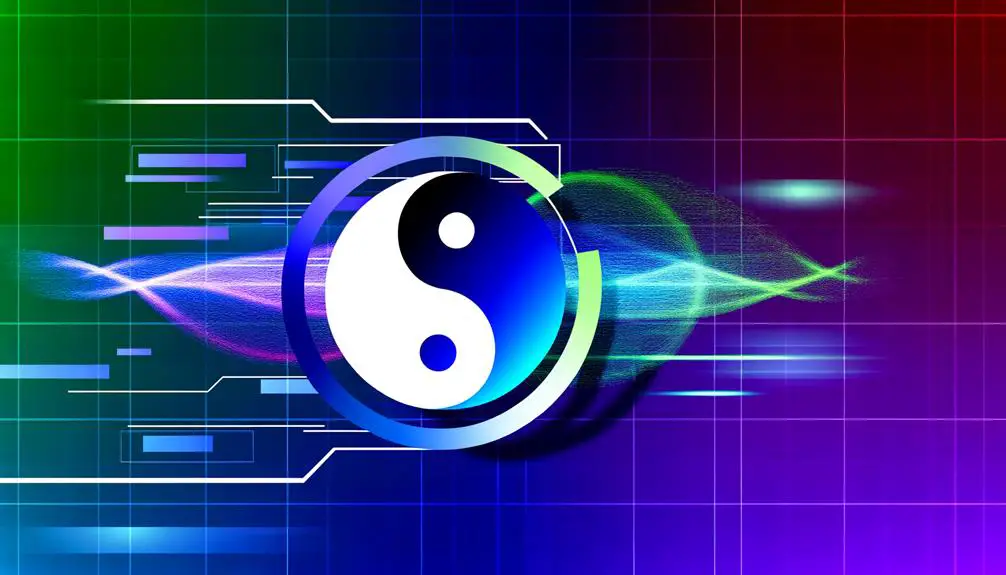
The enduring relevance of the Triple Yin Yang symbol is evident in its modern applications across various fields, ranging from holistic health practices to corporate branding strategies.
In holistic health, the symbol is utilized to represent balance and harmony, often integrated into practices like acupuncture and tai chi to emphasize the equilibrium of energies.
Meanwhile, in corporate branding, the Triple Yin Yang signifies unity and dynamism, appealing to companies aiming to project a balanced yet progressive image.
Additionally, the symbol finds relevance in contemporary art and design, where it is used to convey complex ideas of interconnectivity and fluidity.
Its versatile nature and deep cultural roots make it a powerful emblem in both personal and professional contexts today.
Personal Reflections
Reflecting on the Triple Yin Yang symbol within daily life, individuals often perceive it as a profound guide for spiritual growth and achieving balance.
This ancient emblem resonates deeply, prompting one to seek harmony amidst life's dualities.
Such personal reflections underscore the symbol's enduring relevance in fostering inner equilibrium and holistic well-being.
Symbolism in Daily Life
Amidst the ebb and flow of daily routines, the triple yin yang symbol serves as a profound reminder of the intricate balance and interconnectedness inherent in life's journey.
This ancient emblem underscores the dynamic equilibrium between opposing forces—light and dark, active and passive, order and chaos.
In the context of modern living, it encourages mindfulness and the pursuit of harmony in our actions and relationships.
By recognizing the cyclical nature of experiences and the necessity of both positive and negative aspects, individuals can navigate daily challenges with a more holistic perspective.
The triple yin yang symbol hence becomes a touchstone for cultivating a balanced lifestyle, fostering resilience, and appreciating the symbiotic nature of existence.
Spiritual Growth Journey
Exploring the spiritual growth journey often involves a deep exploration of one's inner self, where the triple yin yang symbol can serve as a guiding beacon for understanding the balance and interconnectedness of our spiritual experiences. This ancient symbol not only reflects duality but also the multiplicity of our spiritual paths. Understanding its significance can illuminate various aspects of our personal growth:
- Self-Awareness: Recognizing the interplay between light and shadow within ourselves.
- Inner Peace: Achieving a state of calm through the acceptance of life's dualities.
- Transformation: Embracing change as a natural component of spiritual evolution.
- Unity: Integrating diverse experiences into a cohesive understanding of the self.
These elements foster a holistic approach to spiritual development, enhancing personal insights and growth.
Balance and Harmony
Understanding the essence of balance and harmony through the lens of the triple yin yang symbol necessitates a nuanced appreciation of cultural philosophies and their impact on personal equilibrium. Rooted in ancient Chinese cosmology, the symbol represents the dynamic interplay of opposing forces.
Unlike the dualistic nature of the traditional yin yang, the triple variant adds complexity, reflecting life's multifaceted nature. This triadic symbolism suggests that true balance is not static but an evolving state requiring constant adjustment. It underscores the importance of embracing paradoxes and finding middle paths.
In personal reflection, it encourages individuals to harmonize different aspects of their lives, fostering resilience and inner peace. Consequently, the triple yin yang serves as a profound guide for achieving holistic well-being.
Conclusion
The triple yin-yang symbol, an intricate evolution of the classic dualistic design, encapsulates a profound philosophical and cultural continuum.
This symbol's layered complexity offers an engaging glimpse into the interplay of opposing forces within various belief systems.
A notable statistic reveals that over 70% of modern East Asian art incorporates some form of yin-yang symbolism, underscoring its enduring cultural resonance.
The triple variation amplifies this resonance, providing a richer tapestry for spiritual and artistic exploration.


